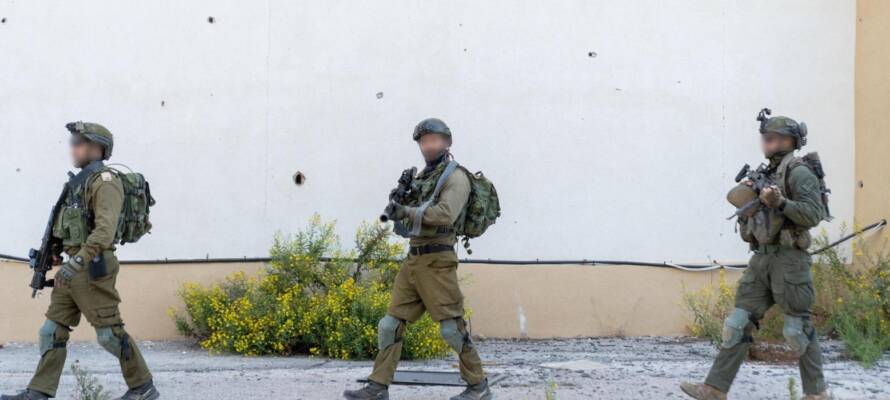There was no sound but the wind. No people, save for us and the Israeli soldiers escorting our small press group.
By Eitan Elhadez-Barak, TPS
We bumped along the rugged dirt road in the armored personnel carrier, the hum of its engine mingling with the crunch of debris beneath its heavy tires.
The screens around us flickered with the grainy feed from external cameras, offering ghostly glimpses of the southern Lebanese village we’d just left.
Claustrophobia clawed at the edges of my composure, but I shoved it aside and focused on the snippets of conversation around me.
That morning, we crossed the “Blue Line,” leaving Israel and entering Lebanon. “When you cross the border, you leave your differences behind. Here, one for all and all for one,” one of the drivers told us.
We walked the ruins of a place that could barely be called a village anymore. Homes reduced to rubble, streets to trenches, and gardens to barren wastelands. A gilded chair sat awkwardly amidst collapsed tree trunks, an echo of what life might have once been.
There was no sound but the wind. No people, save for us and the Israeli soldiers escorting our small press group.
“This was a Hezbollah stronghold,” explained our guide, Lt. Col. Roy Katz, gesturing at the destroyed homes. “A house, a weapons cache, a house again. That’s their strategy—embedding terror into civilian life.”
We followed him to a partially intact home. A child’s chair sat near a pit of rubble, its cheerful colors incongruous against the grey destruction. Katz stopped near it, his boots crunching on shattered tiles.
“Under this house, we found explosives packed alongside medical supplies. They were prepared to transform the mundane into weapons at a moment’s notice.”
It was incomprehensible and, yet, after Gaza, not surprising. Terrorist strategies of blending into civilian infrastructure were well-documented. But seeing it firsthand — standing in what was once a family’s living room and hearing it described as a “barrel of explosives” — added a chilling dimension.
The day’s surrealism wasn’t limited to ruins. Katz told us of the nun the soldiers had encountered amidst the fighting. Even in a Shi’ite-dominated area, her presence felt like something from a film.
The soldiers had escorted her to safety, ensuring she wouldn’t be harmed or inadvertently harm them. It was a flicker of humanity in an otherwise stark landscape of war.
As the armored carrier jolted over another bump, I stared at the screens. The footage showed the blackened remains of an ammunition depot, a symbol of Hezbollah’s military ambitions.
It was unsettling to think about how meticulously they had prepared for war, stockpiling weapons, training forces, and blending it all into the fabric of civilian life. Katz called Hezbollah a “semi-military organization,” though their operations seemed wholly militaristic.
“Monsters,” Hezbollah’s leader, Sheikh Naim Qassem had called Israelis earlier that week. The irony wasn’t lost on me. Hezbollah’s terror had loomed over the region for years, a shadow cast over Lebanon as much as Israel.
When we’d entered Lebanon that morning, it had been in a Hummer, the ride bumpy but open. Now, as we trundled back in the confined carrier, the tension was palpable. The road back was treacherous; a recent clash nearby had underscored the ever-present danger.
Katz’s recounting of a skirmish at an archaeological site –a place sacred to both Jews and Muslims — was fresh in my mind. Violence seemed to thread through every layer of this land, ancient and modern alike.
After the Hamas attacks of October 7, 2023, Hezbollah began launching rockets and launching drones at northern Israel communities daily. More than 68,000 residents of northern Israel are displaced from their homes. Hezbollah leaders have repeatedly said they would continue the attacks to prevent Israelis from returning to their homes.
According to United Nations Security Council Resolution 1701, which ended the 2006 Second Lebanon War, Hezbollah is forbidden from operating in southern Lebanon south of the Litani River.
At least 1,200 people were killed, and 252 Israelis and foreigners were taken hostage in Hamas’s attacks on Israeli communities near the Gaza border on October 7. Of the 97 remaining hostages, more than 30 have been declared dead.
Hamas has also been holding captive two Israeli civilians since 2014 and 2015, and the bodies of two soldiers killed in 2014.
The soldier driving the carrier offered us snacks, and I accepted a granola bar, unwrapping it mechanically. As I took a bite, I thought about the villagers who once lived here, their lives uprooted, their homes turned into battlegrounds.
War strips away the pastoral, leaving behind a landscape of contradictions: destruction and resilience, humanity and inhumanity, light and shadow.
Our tour had ended, but the story was far from over.
